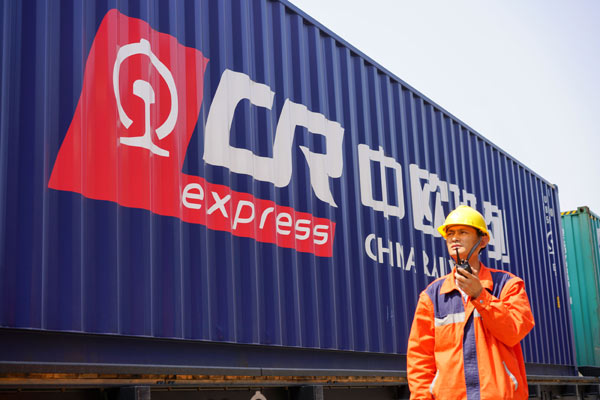‘Belt and Road’ makes progress in connectivity

A worker monitors the loading of containers onto a Chongqing-Xinjiang-Europe intercontinental freight train in Chongqing. The railway will promote a logistics network along the routes.
Construction on the “Belt and Road” initiative has achieved multiple innovations in terms of connecting countries along the proposed routes in the past three years. A new cooperative pattern is emerging that favors all countries in the aspects of policy, infrastructure, trade, funding and culture.
Policy, infrastructure
China and Finland signed a joint statement in April and established a cooperative committee for innovative companies. The two sides also signed eight commercial agreements covering the financial sector, project contracts, clean energy and food processing.
The initiative is being integrated with projects from various countries, such as the “Four Angles” strategy of Cambodia, the “Global Maritime Fulcrum” strategy of Indonesia, Kazakhstan’s “Bright Road,” Russia’s trans-Eurasia superhighway and Mongolia’s “Grassland Road.” More cooperation is on the way. Leaders from Israel, Madagascar and Nepal all expressed their support for the initiative during a recent visit to China.
China has signed nearly 50 agreements with countries along the proposed routes and an additional 70 with departments, including international organizations, according to China’s National Development and Reform Commission.
In terms of infrastructure, the Mombasa-Nairobi Standard Gauge Railway connects Nairobi and Mombasa, the biggest port in East Africa. The 480-kilometers-long railroad is the first to be built since Kenya won its independence, and it is the biggest infrastructure project to be constructed there in the past five decades. It is also China’s first overseas project that involves the whole industrial chain.
Infrastructure connection tops the priority of the “Belt and Road” initiative, such as roads, railways, airports, ports and communication facilities. The Chongqing-Xinjiang-Europe international railway has made a series of breakthroughs. To address the huge variations of temperature along the routes, the research team developed an insulating material to protect electronic products transported in winter. They also developed a satellite positioning and tracking system for cargo and resolved the safety issue of goods transportation.
A variety of landmark projects have been launched, such as the extension of the China-Pakistan Economic Corridor, Indonesia’s Djakarta-Bandung high speed railway and the Hungary-Serbia railway as well as the Upper Marsyangdi A hydroelectric project in Nepal.
Trade, funding
Innovative measures have facilitated trade, including the establishment of cooperation zones. Rayong Industrial Park is one of China’s first batch of overseas economic and trade zones aimed at introducing companies and helping them develop business and adhere to local policies. At present, 80 manufacturing companies funded by China have set up factories in the Rayong Industrial Park with a total investment of more than $2 billion.
According to the statistics of the Ministry of Commerce, Chinese companies have opened 77 cooperation zones in 36 countries, 56 of which are situated in 20 countries along the proposed routes of the “Belt and Road” initiative.
Internet-related innovations have also contributed to the initiative. Alibaba Group and Malaysia jointly launched the first Electronic World Trade Platform outside China to help young people as well as small and medium-sized business in Malaysia and Southeast Asia.
The Khorgas Trans-Border Cooperation Center became the first pilot zone in China for offshore RMB settlement “outside of customs but within the borders” in August 2013. Khorgas, a port in Xinjiang Uygur Autonomous Region between China and Kazakhstan, is not home to a beautiful natural landscape, but it attracted 5 million visitors and businessmen as well as 100,000 vehicle admissions last year.
Financial cooperation is conducted in diverse ways, such as the establishment of the New Development Bank set up by the BRICS, the Asian Infrastructure Investment Bank and Silk Road Fund as well as the cross-border yuan clearing system and electronic commercial platform. From now until 2030, the Asian Development Bank estimates that Asia will require a total of $24 trillion-or $1.7 trillion annually-to fund infrastructure. It is mostly supported by government revenue while foreign direct investment is playing an increasingly important role.
Chinese companies invested a total of $18.5 billion in 20 countries along the proposed routes in 2016, contributing nearly $1.1 billion in tax revenue and creating 180,000 jobs for these countries.
Cultural connectivity
Khabar TV in Kazakhstan broadcasted the finale of a Chinese TV show Singers in which Kazakhstani singer Dimash Kudaibergen competed. His brilliant performance won him fans both in China and his home country. In order to vote for him, many Kazakhstanis began to use WeChat and Weibo, Chinese online social media platforms.
The Ministry of Education recently announced that China has signed agreements with 46 countries on the certification of education credentials, 24 of which are participants in the “Belt and Road” initiative. It also emphasized research on nationalities and regions. More than 140 research topics have been launched, 70 of which are relevant to 46 participant countries of the initiative.
